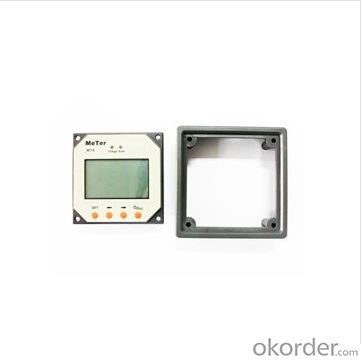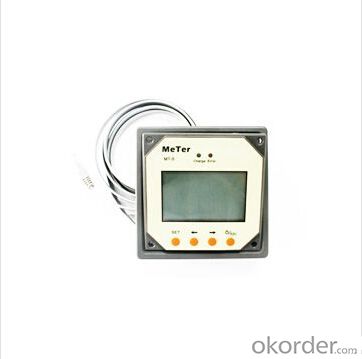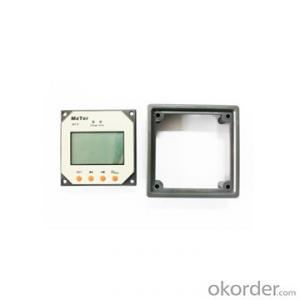Remote Display for Tracer Series,Remote Meter MT-5
- Loading Port:
- Tianjin
- Payment Terms:
- TT or LC
- Min Order Qty:
- 50 pc
- Supply Capability:
- 5000 pc/month
OKorder Service Pledge
OKorder Financial Service
You Might Also Like
MT-5 is an optional accessory for Tracer series solar charge controller. The LCD displays the system status and parameters clearly.
Features:
·Display the system status and parameters with digital and graphic icon.
·Battery type selectable
·Battery Ah setting function
·Temperature compensation coefficient adjustable
·Four keys to solve the setting easily
·Control the load by manual
Specification:
Rated voltage | 12V, min voltage (suggest): 8.0V |
Strong backlight on | <23mA |
Low backlight on | <20mA |
Backlight and LED indicator off | <17mA |
Operation temperature | -40℃ ~ +60℃ |
LCD operation temperature | -10℃ ~ +40℃ |
Humidity | 0-100% |
Communication cable | RJ45(8PIN), 2 meter |
Battery voltage parameters (temperature at 25°C) | |||
Battery charging setting | Sealed | Flooded | Gel |
Equalize charging voltage | 14.4 V;x2/24V | 14.6V;x2/24V | 14.8V;x2/24V |
Boost charging voltage | 14.2V;x2/24V | 14.4V;x2/24V | 14.6V;x2/24V |
Float charging voltage | 13.7V;x2/24V | 13.7V;x2/24V | 13.7V;x2/24V |
Max. solar voltage | 30V(12V system),55V(24V system) | ||
Battery voltage range | 8-15V(12V system),8-30V(24V system) | ||
Self-consumption | 4mA at night, 10mA at charging | ||


FAQ:
Q1. What is the voltage?
A1. Our 45/60A solar charge controller is 12/24/36/48V auto work.
Q2. What is the difference between MPPT&PWM?
A2. MPPT has higher efficiency, it can track the max power point and won't waste energy.
Q3. What is the efficiency of the MPPT controller?
A3. MPPT>99%, peak conversion efficiency>98%.
Q4. What is the waranty of product?
A4. 12 months.
Q5. What protection does your MPPT controller have?
A5. PV array short circuit, PV reverse polarity, Battery reverse polarity, Over charging, Output short circuit.
- Q:What is the temperature rating of a solar controller?
- The temperature rating of a solar controller typically refers to the maximum and minimum temperatures at which the controller is designed to operate efficiently and effectively. The temperature rating will vary depending on the specific model and manufacturer, but in general, most solar controllers have a temperature rating between -20°C to 55°C (-4°F to 131°F). It is important to consider this temperature rating when selecting a solar controller for your system, as operating outside of the recommended temperature range can potentially lead to reduced performance or even damage to the controller.
- Q:What is the purpose of the battery state of health monitoring feature on a solar controller?
- The purpose of the battery state of health monitoring feature on a solar controller is to ensure optimal performance and longevity of the battery. It allows the controller to accurately measure and track the health of the battery over time, providing valuable information on its overall condition and capacity. By monitoring the battery state of health, the solar controller can take appropriate actions to maintain and prolong the battery's lifespan, such as adjusting charging and discharging parameters, preventing overcharging or deep discharge, and alerting the user if any issues arise. This feature helps users to maximize the efficiency and reliability of their solar system, as well as avoid potential battery failures or degradation.
- Q:Do solar controllers require regular maintenance?
- Yes, solar controllers do require regular maintenance. While they are designed to be durable and reliable, regular maintenance is necessary to ensure their optimal performance and longevity. Some common maintenance tasks include cleaning the solar panels to remove any dirt or debris that could reduce their efficiency, inspecting the wiring and connections for any signs of damage or corrosion, and checking the controller's display and settings to ensure they are functioning properly. Additionally, it is recommended to periodically test the system's battery voltage and charge controller settings to ensure they are operating within the desired parameters. Regular maintenance not only helps to identify any potential issues early on but also helps to maximize the efficiency and lifespan of the solar controller.
- Q:Which parts are broken, how to repair
- May be the screen power supply circuit is broken, it is best to ask the professional repair under.
- Q:Can a solar controller be used with a solar-powered residential building?
- Yes, a solar controller can be used with a solar-powered residential building. A solar controller is an essential component in a solar power system as it regulates the charging and discharging of batteries, manages power flow, and optimizes the performance of the solar panels. It ensures that the solar energy generated is efficiently stored and utilized, making it suitable for use in residential buildings powered by solar energy.
- Q:What is the discharge current rating of a solar controller?
- The discharge current rating of a solar controller refers to the maximum amount of current that can be drawn from the battery bank by connected loads or devices. This rating is important as it ensures that the solar controller can safely handle the power demands of the connected equipment without causing damage to the battery bank or the system as a whole.
- Q:Can a solar controller be used with a solar-powered drone?
- Yes, a solar controller can be used with a solar-powered drone. A solar controller is designed to regulate and optimize the charging and discharging of solar panels, which can be beneficial for a solar-powered drone to ensure efficient power management and longer flight times.
- Q:Can a solar controller be used with both battery-based and grid-tied solar systems?
- Yes, a solar controller can be used with both battery-based and grid-tied solar systems. The solar controller helps regulate and optimize the charging and discharging of batteries in battery-based systems, while in grid-tied systems it helps regulate the flow of power between the solar panels and the grid.
- Q:Can a solar controller be used in grid-tied systems?
- No, a solar controller cannot be used in grid-tied systems. Grid-tied systems do not require a solar controller as they are connected to the electrical grid and rely on inverters to convert the DC power generated by solar panels into usable AC power for the grid. A solar controller is used in off-grid systems to regulate and control the charging of batteries.
- Q:What is the maximum load voltage a solar controller can handle?
- The maximum load voltage a solar controller can handle typically depends on the specific model and manufacturer. However, most solar controllers can handle load voltages ranging from 12V to 48V.
1. Manufacturer Overview |
|
|---|---|
| Location | |
| Year Established | |
| Annual Output Value | |
| Main Markets | |
| Company Certifications | |
2. Manufacturer Certificates |
|
|---|---|
| a) Certification Name | |
| Range | |
| Reference | |
| Validity Period | |
3. Manufacturer Capability |
|
|---|---|
| a)Trade Capacity | |
| Nearest Port | |
| Export Percentage | |
| No.of Employees in Trade Department | |
| Language Spoken: | |
| b)Factory Information | |
| Factory Size: | |
| No. of Production Lines | |
| Contract Manufacturing | |
| Product Price Range | |
Send your message to us
Remote Display for Tracer Series,Remote Meter MT-5
- Loading Port:
- Tianjin
- Payment Terms:
- TT or LC
- Min Order Qty:
- 50 pc
- Supply Capability:
- 5000 pc/month
OKorder Service Pledge
OKorder Financial Service
Similar products
New products
Hot products
Related keywords





























